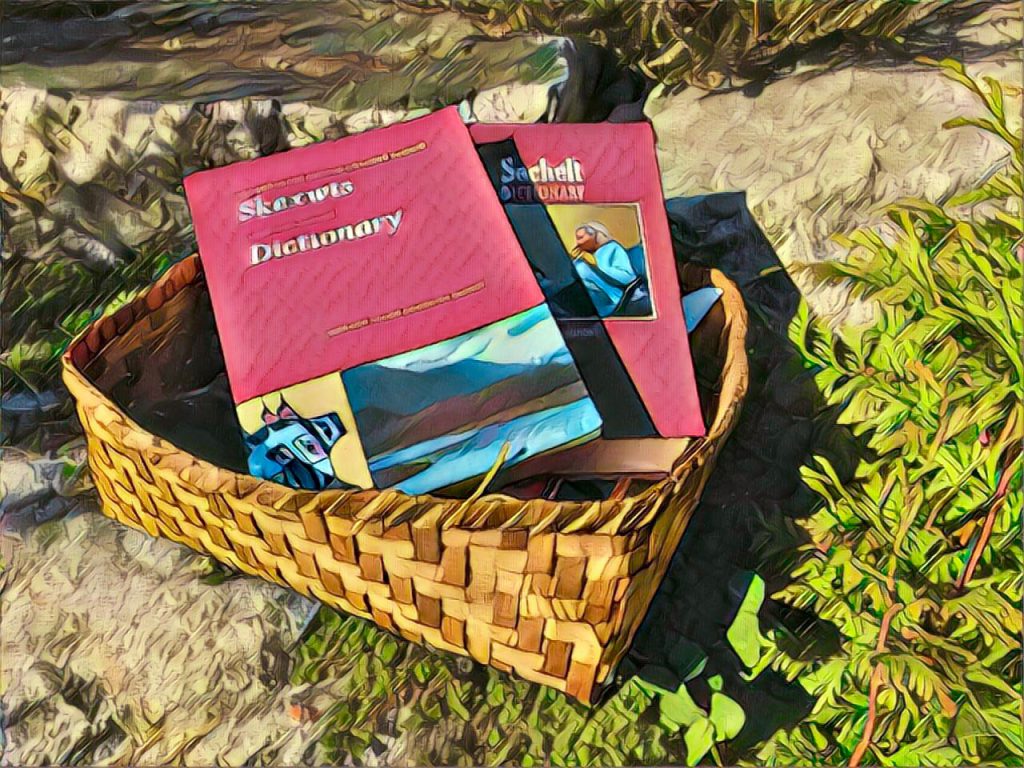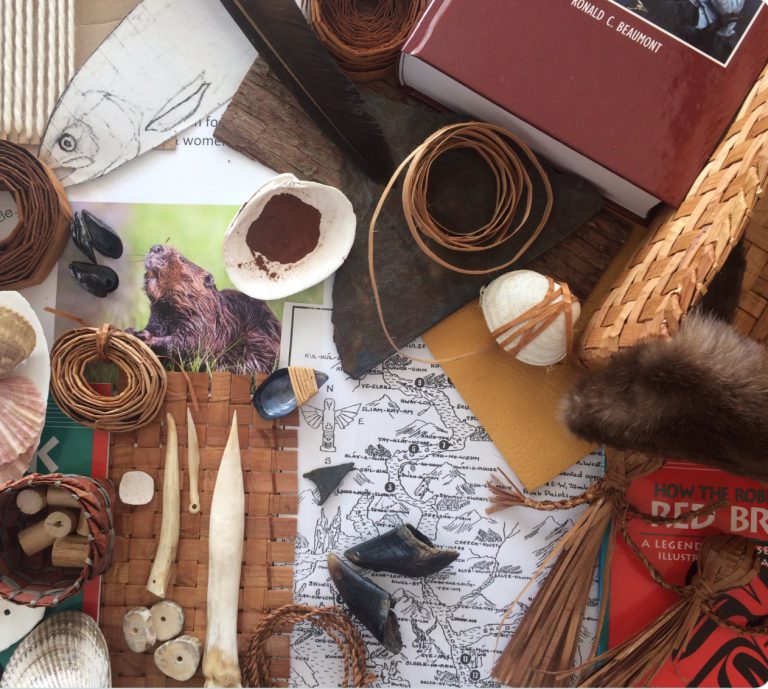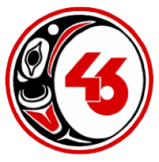Learning Resources

shishalh culture basket created by Jessica Silvey featuring She shashishalhem and Skwxwú7mesh snitchem dictionaries
WELCOME TO THE INDIGENOUS LEARNING RESOURCES BASKET
We are grateful to the Inuit, Métis and First Nations knowledge keepers who shared, created and contributed to these resources. We acknowledge the Indigenous and non-Indigenous researchers, librarians, archivists, artists, photographers, writers, web designers and technologists who brought knowledge to light. We thank the thoughtful educators from other school districts across BC and Canada – and right here in SD46 – who collected these resources. We hold our hands up in gratitude to the SD46 staff who helped to make these web pages possible.
We also encourage SD46 colleagues to regularly check the Engage site for Indigenous Peoples’ Teachings and Learning information and resources. Collected and vetted over many years, there are literally hundreds of articles, documents and connections to learning resources posted there for classroom teachers, district staff, and support staff to access. For the most part, this web page does not duplicate what is on the Engage site. We recommend using both.
Look for this icon on Engage:
We will add to ideas and resources as time goes on, so please return regularly to check the baskets and the Engage site for new additions.
In This We Journey Together
Resource links on this page
Posters, Timelines and Maps
- First Peoples Principles of Learning Poster
- Key Moments in Indigenous History – A Timeline
- Native Land Map (World – Interactive)
- Indigenous Peoples Atlas of Canada – First Nations
- Indigenous Peoples Atlas of Canada – The Métis
- Indigenous Peoples Atlas of Canada – Inuit
- First Peoples’ Map of BC (Interactive).
- Residential Schools of Canada Map
- The Decolonial Atlas: The Decolonial Atlas is a growing collection of maps which, in some way, help us to challenge our relationships with the land, people, and state. It’s based on the premise that cartography is not as objective as we’re made to believe. The orientation of a map, its projection, the presence of political borders, which features are included or excluded, and the language used to label a map are all subject to the map-maker’s bias – whether deliberate or not. Because decolonization is a process of unlearning and rediscovering, they are especially committed to Indigenous language revitalization through toponymy – the use of place names.
- The Original Names for the Great Lakes by Craig Baird
- 21 Things You May Not Know About the Indian Act Poster
Indigenous Education Resource Inventory
- This inventory is a non-comprehensive list of Indigenous education resources that has been compiled by the Ministry of Education in collaboration with the British Columbia Teacher’s Federation, the First Nations Education Steering Committee, and Métis Nation British Columbia. The intent of these materials is to help further incorporate Indigenous knowledge and perspectives into B.C. classrooms. The inventory includes guides, books and e-books, articles, websites, videos, and other materials. Educators may also find this inventory useful for supporting personal and professional Indigenous learning.
First Nations Education Steering Committee (FNESC) RESOURCES.
These are the resources referred to in the Professional Development Resources section – within the Continuing Our Learning Journey: Indigenous Education in B.C. modules.
- In Our Own Words – Bringing Authentic First People’ Content to the K – 3 Classroom
- Shared Learnings – Integrating BC Indigenous Content. K- 10. (older, so curriculum references are out of date – but some strategies still relevant – use thoughtfully)
- Authentic First Peoples Resources Guide
- Indian Residential Schools & Reconciliation – Teacher Resource Guide – Grade 5
- Indian Residential Schools & Reconciliation – Teacher Resource Guide – Grade 5 – pdf version
- Indian Residential Schools & Reconciliation – Teacher Resource Guide 10
- Indian Residential School & Reconciliation – Teacher Resource Guide – Grade 10 – pdf version
- Indian Residential Schools & Reconciliation Teacher Resource Guide 11 – 12
- Learning Resource for Senior Secondary – Book 1
- Learning Resource for Senior Secondary – Book 2
- Indian Residential Schools & Reconciliation – Additional Resources
- Science First Peoples Grades 5- 9 Teacher Resource Guide (highly recommended – some cross curricular value)
- Science First Peoples Grade 5 – 9 Teacher Resource Guide
- Math First Peoples Resource Guide 8 – 9 (but also applicable to other grade levels)
- English First Peoples Grade 10, 11, 12
- English First Peoples Grade 10, 11, 12 – pdf version
- BC First Nations Land, Title, and Governance (highly recommended – cross curricular value)
- Career Journeys First Nations Career Role Model Program
United Nations Declaration on the Rights of Indigenous Peoples
- United Nations Declaration on the Rights of Indigenous Peoples
- Canada has committed to a renewed, nation-to-nation relationship with Indigenous peoples based on recognition of rights, respect, co-operation and partnership, and rooted in the principles of the United Nations Declaration on the Rights of Indigenous Peoples.
- B.C. Declaration on the Rights of Indigenous Peoples Act
- BC UNDRIP – Legislation Fact Sheet
Languages
- FirstVoices is a suite of web-based tools and services designed to support Indigenous people engaged in language archiving, language teaching and culture revitalization
- The Status of BC First Nations Languages in BC
- Status Census Brief: First Nations People, Metis and Inuit
- Langagues
- Some shíshálh phrases – sháshishálhem
Science
Housed by the Australian Council for Educational Research (ACER) research repository. Culturally competent science teaching: cultures from around the world including Canada
Literature
Elders
Identity
- What is Indigenous Identity?
- Understanding Indigenous Identity
Understanding Indigenous Identity explores the complex issue of self-identification for Indigenous people. Today, Indigenous identity remains inextricably linked with past government legislation and the continued stereotyping of Indigenous people in the media and Canadian history. From a Metis farm in rural Alberta to the offices of Canada’s leading scholars, Understanding Indigenous Identity examines the factors that shape who we are. - ‘Two Worlds’, is the first Music Video in the ‘Identity Matters’ series produced with Indigenous students from Catholic Education across Queensland. The series reflects the student’s culture and what it means to them being an Indigenous Australian.
https://www.youtube.com/watch?v=Slvd0OYD2_o - Bob Randall, a Yankunytjatjara elder and traditional owner of Uluru (Ayer’s Rock), explains how the connectedness of every living thing to every other living thing is not just an idea but a way of living. This way includes all beings as part of a vast family and calls us to be responsible for this family
- “Raven Comes Full Circle”– Short Film by Dorothy Grant
- Intangible Cultural Heritage– UNESCO
- Úxwumixw 2050: Sḵwx̱wú7mesh Generational Plan
- Metis Identity
- Indigenous Peoples Atlas of Canada
Truth and Reconciliation
- Indigenous Peoples Atlas of Canada – Truth and Reconciliation
- National Centre for Truth and Reconciliation
- Reports and Findings of the Truth and Reconciliation Commission of Canada
- Teaching Resources
- Blanket Exercise Resources
- Witness Blanket
Inspired by a woven blanket, Carey Newman has created a large scale art installation, made out of hundreds of items reclaimed from Residential Schools, churches, government buildings and cultural structures including Friendship Centres, band offices, treatments centres and universities across Canada. The Witness Blanket stands as a national monument to recognize the atrocities of the Indian Residential School era, honour the children, and symbolize ongoing reconciliation. - The Honourable Murray Sinclair – Official Obituary
BCTF Resources
- Gladys We Never Knew
- Project of Heart
- Orange Shirt Day
- Shattering the Silence – University of Regina Indian Residential School Resource Guide
- UBC Indian Residential School History and Dialogue Centre
- Why We Need Truth before Reconciliation- a podcast by Ry Moran
- Strengthening the Heartbeat of Reconciliation – excellent resource from Alberta Teachers Association
- Truth before Reconciliation: 8 ways to identify and confront Residential School denialism
Teaching the Truth: Why education needs to be informed and led by Indigenous Peoples
- How the Idle No More movement changed Canada
Land Acknowledgement
Decolonizing Education
Reclaiming Ancestral Ties to Lands and Waters
First Nations Activism
Anti-Racism
First Peoples’ Health
Indigenous Youth Mental Health
Cedar
Fishing
Canoe
The Sturgeon Nosed Canoe a segment on the history and making of a contemporary Sturgeon-nosed canoe.
Start at 15:36
- Canoes of the Pacific Northwest
- Dugout Canoe
- Learning How to Carve a Canoe
- Sturgeon Nose Canoe –
The Rebirth of the White Pine Sturgeon Nose Canoe
- Sturgeon Nose Canoe – Salishan Sturgeon Nose Canoes
- Sturgeon Nose Canoe – ‘We are Still Here’
Salmon
Medicines
Plants
Water Walkers
Historic Town - Barkerville
Storytelling
- Chilcotin Oral Storytelling
- Nch’ḵay̓: Skwxwú7mesh Great Flood Story
- A Paddle Story – The story of Philip Paul Weenah and three poles that used to stand on the Sechelt promenade
Animals of Significance
Northwest Coast
Residential Schools
Red Dress Day
Bears
Spirit Bears (English with French sub titles)
In a world full of green, the spirit bear stands out immediately. Spirit bears are a rare sub-species of black bear present in British Columbia. 1/10 of the bears have white-coloured coats. There are estimated to be about 400 spirit bears in the world, 40 of which are white. The Gitga’at Nation has worked tirelessly to protect the spirit bear and its habitat.
Poles
- The Art of Poles (English with French sub titles)
In the Haida culture, the cedar tree is known as the ‘tree of life’. Among the many uses, these trees are also used for one of the well-known symbols of Haida culture – poles. Haida poles tell a story through the representation of human, animal and supernatural figures. Haida carver Tyler York offers insight about this incredible tradition.
Carving
- bent knife demo
Steve Brown demonstrating the use of a bent knife carving a mask at the Port Townsend School of Woodworking - Coast Salish Master Carver
Randy Goldsmith: Coast Salish Master Carver discusses his history, training and techniques in the art of West Coast First Nations Carving - Paddle Pendant (novice woodworking project)
- Canoe Bowl (intermediate woodworking project)
- Paddle Making (intermediate woodworking project)
Quillwork
- Porcupine Quill
- Quillwork – The Canadian Encyclopedia
- Quillwork – Indigenous Artistry
- Quillwork – Mi’kmaq Culture
- Quillwork – Show Me Your Math
Dance
The Dancers of Damelahamid of the Gitxsan Nation (‘People of the River Mist’)
- Raven Dance
- The Ulukhaktok Western Drummers and Dancers Shot in and around Ulukhaktok, Northwest Territories, September 2012
- The Aklavik Delta Drummers and Dancers
- Inuvik Drummers and Dancers
Inuit Circumpolar Council (ICC) General Assembly 2014 - The Tuktoyaktuk Siglit Drummers and Dancers
Shot in and around Tuktoyaktuk, Northwest Territories, September 2012. - History of the Métis Jig
- Sagkeeng’s Finest
Gathering Our Voices 2013 Talent Show featuring “Sagkeeng’s Finest” winner of Canada’s Got Talent 2012. A three-member traditional dance troupe from Manitoba’s Sagkeeng First Nation. - Four Nations Square Dancers
performing Live at Dauphin Friendship Centre Annual Square Dance Competition on Saturday April 27, 2013. - United Thunder
Salish
Knowledge
Cultural Celebration
- Hobiyee
Kincolith Nisga’a dancers enter Hobiyee 2016 - Gitsegukla Gidahmes Dancers perform last song with Gitanyow and Kitwanga dancers at the New Aiyanch Hobiyee 2016
- The Living History of Powwow parts 1 and part 2
First Nations, Métis and Inuit Knowledge and Resources
First Nations
- 7 Ojibway Teachings
Manitoba First Nation Elder Dave Courchene explains the origins and lessons of the First Nation Seven Teachings. The lessons of the Bear Spirit (Courage), the Beaver Spirit (Wisdom), the Eagle Spirit (Love), the Buffalo Spirit (Respect), the Sasquatch Spirit (Honesty), the Wolf Spirit (Humility) and the Turtle Spirit (Truth) are all retold in this 11 minute video in both English and Ojibway. - Traditional Foods Fact Sheet
- First Nations Food Guide
- Healthy Foods
- Inuit Traditional Foods
- Inuit Storytellers and Health Promotion during Changing Times
- Recipes (1)
- Recipes (2)
- A First Nations Cooking Class On National Indigenous Peoples’ Day
- Museum of Anthropology, UBC – School programs online resources. MOA offers teaching kits, panel exhibits and guided studies for use in the classroom. 15-day rentals are $40 and 30-day rentals are $75.
- Making Cottonwood Salve and Cottonwood Tincture (Nadine McSpadden)
Mathematics
- Mathematics Indigenous Knowledge
- Squamish-Lilwat Cultural Centre Mathematics Booklet
- Math First Peoples Resource Guide 8 -9 (but also applicable to other grade levels)
- Coast Metro Consortium announces the ELEMENTARY COAST METRO MATH PROJECT
Science
- Differences between Western meteorology and traditional Indigenous approaches to weather
- First Nations Whose Territories Are Within What is Now Known as British Columbia
shíshálh Nation
- Strategic Land Use Plan for the shíshálh Nation
- Sechelt Indian Band Self-Government Act
- Skwxwú7mesh Nation
- Celebrating 100 years of Shishalh Nation Amalgamation
- Strategic Land Use Plan for the Skwxwú7mesh Nation
- Sen̓áḵw development set to generate billions for Sḵwxwú7mesh
- First Peoples – A Guide for Newcomers (Vancouver area)
- xʷməθkʷəy̓əm. Musqueam Nation (1)
- xʷməθkʷəy̓əm. Musqueam Nation (2)
Métis
- Gabriel Dumont Institute
The mission of the Gabriel Dumont Institute is to promote the remewal and development of Métis culture though research; materials development, collection, and distribution; and the design, development and delivery of Métis-specific educational programs and services. Louis Riel Institute Adult Learning Centre
- The Louis Riel Institute is the Métis educational and cultural institute that promotes education and training for Métis people in Manitoba, and fosters an appreciation of the culture, heritage and history of the Métis people of Manitoba.
Click on “Culture” for valuable information
- BC Métis Federation
A number of contributions by George and Terry Goulet, BCMF Historical Consultants and residents of the Sunshine Coast
- Traditional Dog Teaming
Movie – produced in 1995, depicting mid 1940s lifestyle Michif Language and Métis Culture lesson plans – Mostly elementary but there are a few secondary level lessons as well.
Governance
- Wampum Belts
- Treaties
Includes pedagogical considerations when teaching about treaties From historic to modern day treaty process – a great resource to get you started!



